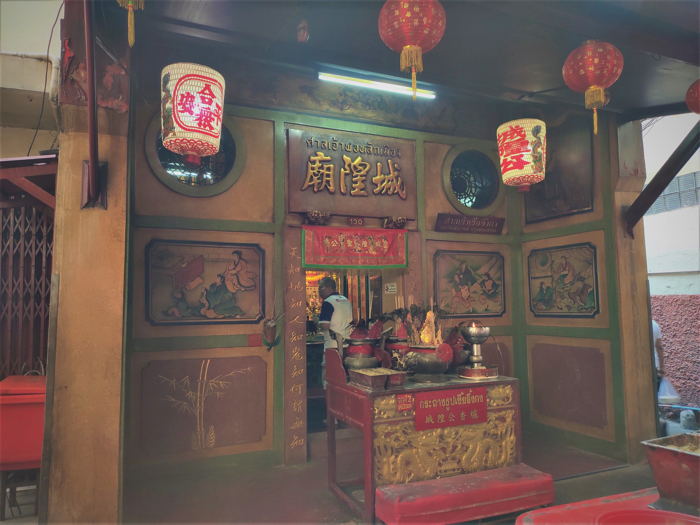- Project Leader : Jie Huang (Kyoto University, Graduate School of Asian and African Area Studies)
Outline of Research
This research is an ethnographic study on the folk beliefs of “lak muang” (city pillar, the God of Land) in mainland Southeast Asia, with the case study of Thailand. “lak muang” has been regarded as a folk belief of Tai-speaking peoples in mainland Southeast Asia that was an important element in the construction of their traditional political social system. However, in reality, the faith of “lak muang,” which was generated and maintained in the context of Thailand’s Buddhism, is a syncretistic fusion of folk and indigenous beliefs. Although the syncretism of “lak muang” and other folk beliefs is common in Thailand, existing studies have not paid much attention to such syncretism. Therefore, this research will analyze syncretism by applying the religious theory of Japanese Folklore Studies to religious phenomena in Thailand.
Description
The purpose of this research is to reconsider the syncretism situation and the process of reconstruction of “lak muang” among Tai people in Mainland Southeast Asia. The faith of “lak muang” is a popular folk belief related to the local political power among Tai-speaking ethnic groups, that has been regarded as an important perspective to understand culture of Tai people [Mori 1989]. “lak muang” is usually a wooden pillar, expressing as a material symbol combined with the guardian spirit of the land. In addition, “lak muang” was generally combined with local powers that were different from the nation. The temple of “lak muang” is widely observed in North Thailand, Yunnan Province of China, Highland Myanmar, North Vietnam, Laos, Sipsong Panna and other places. In Thailand, nearly every city owns its city pillar (lak muang) as the guardian spirit of the city’s land, most of Thai people visit the “lak muang” temple for prayer and worship the city pillar frequently. Though “lak muang” mainly represents male genitalia, there are various kinds of “lak muang” temples in Thailand, even some in Chinese style.
Precedent researches mainly focus on the structure of political power associated with “lak muang” (city pillar or village pillar), especially the case of Tai Dam or Shan. It has been pointed out that the pillar of the village is characterized both as the power of the Lord’s power and the guardian spirit of the village [Mori 1989; 1991; 1992, Murakami 1997]. In addition, there was also discussion on the consciousness of the history of immigrants expressed in the worship and sacrifices of “lak muang” [Baba 1993], or discussion on the worship of “lak muang” that help different ethnic groups eliminate differences and live together [Nagatani 2004]. However, the syncretism phenomenon of “lak muang”, which representing the complexity of religion in Thailand has not yet been paid much attention.
The purpose of this research is to reconsider and reexamine the faith of “lak muang” with the case studies of Thailand from the new perspective of Folklore Studies. Particularly speaking, through literature survey and field investigation, this research will focus on and try to solve the following question. That is, what is the current situation of the worship and sacrifices of “lak muang” in Thailand? and, how has it been positioned within the context of the politics, religion, history and culture of Thailand?
With new materials and data obtained by investigation, this research will promote the research on the religious theory of Thailand and the worship of guardian spirit. Moreover, instead of using the political viewpoint of precedent studies, this research tries to develop a new perspective with the knowledge of Japanese Folklore Studies. Although the special circumstances of Japan are different from the situation in Mainland Southeast Asia, the observation of these difference can also raise the possibility of the reconsideration on Japan’s theory of Southeast Asian religion.
References
Mori, Mikio. Notes on the cults of the lak muang among the Tai peoples (1)(2)(3). Journal of Asian and African Studies, 1989, 38: 91–109. 1991, 41: 125–136. 1992, 43: 123–147.
Murakami Tadayoshi. On the Dual Structure of “Guardian Spirit” and “Community Pole” in a Tai Yai(Shan) Village in Northern Thailand: a Preliminary Work for the Study of the Shan Religion. YAKARA: Studies in Ethnology, 1997, 29: 2–25.
Nagatani Chiyoko. Opening a Space with Others: On the Practice of the Dehong Dai at Guan-Gong Shrine in Mangshi, Yunnan. Annual report of social anthropology, 2004. 30: 63–87.
Baba Yuji, Migration and Spirit Ritual of the Tai-Lue. Annual report of social anthropology,1993, 19: 133–147.


